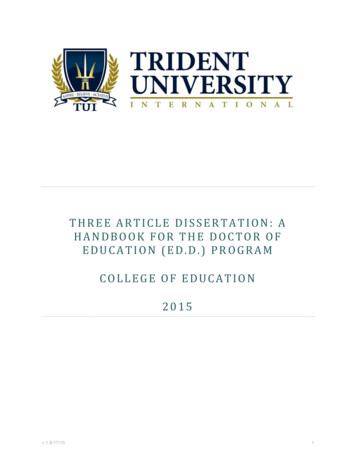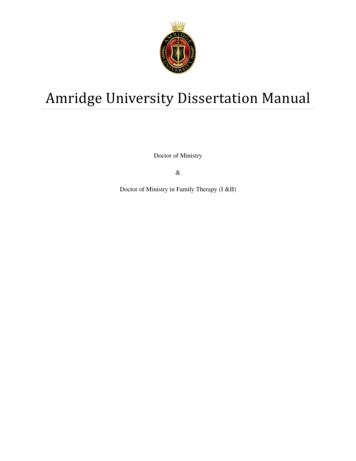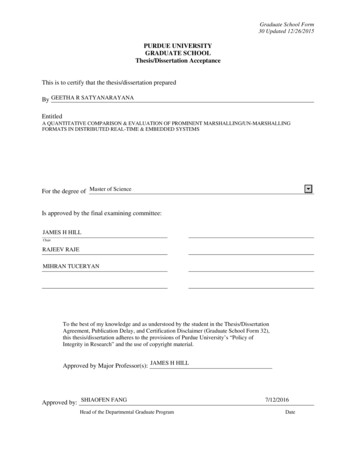
Transcription
THREE ARTICLE DISSERTATION: AHANDBOOK FOR THE DOCTOR OFEDUCATION (ED.D.) PROGRAMCOLLEGE OF EDUCATION2015v.1 8/17/151
TABLE OF CONTENTSOverview: Guide to Doctoral Dissertation Research. 4General Degree Requirements . 5An Introduction to the Three Article Dissertation . 6Three Article Dissertation Formats . 8Progressive or Developmental Format . 8Single Study/Interdependent or Recursive Format . 9Independent or Major Project Format. 9Sample Three Article Dissertations. 10The Development of Your Three Article Dissertation . 12Dissertation Timeline. 13EDD 800: Dissertation Tasks or Doctoral Positioning System. 14Selecting a Problem of Practice. 15Dissertation Committee Selection . 17Dissertation Committee Approval of the Applied Research Plan . 18Institutional Review Board . 19The Special Case of the Organizational Analysis . 19After IRB Approval of Your Research Plan . 19Submission of Articles for Publication . 20Completing the Dissertation . 21The Oral Defense . 21Philosophy of the Oral Defense . 21Procedures for the Oral Defense. 22Outcome of the Oral Defense. 22Edit and Submit the Dissertation After the Defense . 23Use of APA Style in the Dissertation . 24Dissertation Style Sections of a Dissertation. 24Why Formatting Requirements Are Specific. 24Arrangement of Contents . 24Page Composition . 25Typeface . 25Margins . 25Spacing . 26v.1 8/17/152
Equations and Formulas. 26Widows and orphans . 26Justification . 26Titles of Sections . 26Pagination for Front Matter . 27Pagination for the body of the dissertation . 27Two Volume Dissertations . 28Title Page. 28Biographical Sketch . 29Dedication . 29Acknowledgments. 30Table of Contents . 30Lists of Figures, Tables, or Illustrations . 30Abstract . 30Footnotes . 31The Use of Foldouts is Not Allowed . 31Tables and Figures. 31Photographs . 32References . 32Acknowledging the Work of Others . 33Copyrighted Material . 33Appendices . 33Production of the Dissertation. 33Computers and Printers . 34Making Copies and Meeting Paper Specifications . 34Ed. D. Dissertation Formatting Checklist . 35Submitting the Dissertation to ProQuest UMI . 37References . 38v.1 8/17/153
OVERVIEW: GUIDE TO DOCTORAL DISSERTATION RESEARCHThe completion of a dissertation is one of the requirements for conferral of a doctorate, the highestacademic degree offered. The Ed.D. Program at Trident University is intended for mid-careerprofessionals who wish to prepare for the additional responsibilities they face as leadershipprofessionals in education. A Doctor of Education degree recognizes the student’s superiorpreparation for leadership roles in the field of education. The dissertation is also a permanentrecord of your applied research. Trident University is committed to the preservation anddissemination of the research contributions of its graduates.The Ed.D. Program at Trident University International requires the completion of a Three ArticleDissertation. This handbook is intended to introduce you to the Three Article Dissertation (TAD),provide you with an understanding of how the TAD is supported throughout the curriculum, andfamiliarize you with the steps of the dissertation process. In addition, this handbook includesrecommended strategies and timelines to assist doctoral students in successful completion of theTAD. This handbook is a guide and not intended to alter or modify the requirements set forth ineither the Academic Programs or Policy Handbook of the University Catalog.In the Ed. D. program, the development of your dissertation research is integrated within yourresearch course sequence. The Applied Research course sequence (EDD 605 and EDD 607) willsupport you through the initial steps of the dissertation process. The first dissertation supervisioncourse is EDD 680. The goals of this course are to identify the problem of practice you will study,complete a brief literature review, select a dissertation committee, submit a brief proposal for yourdissertation research, and complete the Trident University Institutional Review Board (IRB)requirements. After successful completion of the course, you may begin your dissertation research. Youmay also need to consider completion of any IRB requirements at the site under study.The doctoral supervision sequence includes EDD 680, EDD 690, and EDD 700. These courses assistyou with the completion of tasks (or milestones) related to completion of the dissertation. Allstudents are also enrolled in EDD 800: Dissertation Tasks at the start of their program. This courseis not linked to a specific session and is always available for students to view. The purpose of theEDD 800, also known as the Doctoral Positioning System or DPS, is to serve as a repository for allyour approved and finalized dissertation documents. All content uploaded to EDD 800 may beviewed by you, the dissertation chair, the program mentor, and the program director.4v.1 8/17/154
GENERAL DEGREE REQUIREMENTSAll requirements for the doctoral degree (including completion of required coursework andsubmission of your dissertation in a format that meets Trident University International criteria)must be completed within nine years following your first enrollment in the Ed. D. program. Pleasereview the university catalog for more information on the program requirements and policy relatedto maximum time to degree.The Ed.D. Program requires completion of 60 units (48 units of coursework and 12 units ofdissertation coursework). The normal time to degree is 3 years. A typical program of study isprovided in Table 1. The sequence of dissertation supervision courses includes EDD 680, EDD 690and EDD 700. The standard expectation is that students will be ready to defend their dissertationat the end of EDD700.Table 1Program of Study: K12 Leadership ConcentrationCourseworkEDD 602 Leadership Theory & Practice (4)EDD 605 Applied Research (4)EDD 603 Effective Communication for Educational Leaders (4)EDD 607 Advanced Applied Research (4)EDD 634 Current Issues in PK-12 Education (4)EDD 680 Dissertation Supervision I (4)EDD 611 Strategic Planning and Finance for Educational Leaders (4)EDD 612 Assessment and Program Evaluation in Education (4)EDD 632 Legal Aspects of Education Leadership (4)EDD 690 Dissertation Supervision II (4)Concentration course (4)Concentration course (4)Concentration course (4)Concentration course (4)EDD 700 Dissertation Supervision III (4)Table 2Program of Study: Higher Education Leadership ConcentrationCourseworkEDD 602 Leadership Theory & Practice (4)EDD 605 Applied Research (4)EDD 603 Effective Communication for Educational Leaders (4)EDD 607 Advanced Applied Research (4)EDD 640 Current Issues in Higher Education (4)EDD 680 Dissertation Supervision I (4)EDD 611 Strategic Planning and Finance for Educational Leaders (4)EDD 612 Assessment and Program Evaluation in Education (4)EDD 632 Legal Aspects of Education Leadership (4)EDD 690 Dissertation Supervision II (4)EDD 642 Student Development Theory (4)EDD 641 Higher Education Administration (4)Concentration course (4)Concentration course (4)EDD 700 Dissertation Supervision III (4)5v.1 8/17/155
AN INTRODUCTION TO THE THREE ARTICLE DISSERTATIONMany people are familiar with the traditional “5-chapter” dissertation that typically includes thefollowing chapters:1. Introduction2. Review of the Literature3. Methodology4. Results5. Discussion and ConclusionThe Doctor of Education is a professional practice degree intended for the working professional andthe traditional 5-chapter dissertation may not be the best fit for a professional practice doctoralprogram. The 5-chapter format is not similar to any of the types of research a leader in education islikely to participate in within their work day. It has also been a problem in other disciplines wherealternatives have been used for decades, in part because the major medium of scholarlycommunication is the journal article and dissertations are difficult to convert to articles.Various approaches to an EdD. Program’s final product are being investigated by severalUniversities who are part of the Carnegie Foundation’s Carnegie Project on the Education Doctorate(CPED, see the web site http://cpedinitiative.org). While some programs indicate thatWe have deliberately avoided being too specific about the format of the finalproduct so that communities would be free to generate an outcome format inharmony with the work. Our examples included: a book with a co-authoredintroduction and summary but individually authored chapters; a series of journalarticles; or a technical report and single journal article. We stipulated that thereshould be a written product and two oral presentations, one to a community ofpractitioners and one to the university community. (CPED, 2013)The Ed.D. Program at Trident University International will focus on research in practice andborrows the “three article dissertation” or TAD format from the sciences and engineering where ithas been developed and used for many years. The TAD, or a variation of it, has also become popularin many of the new applied and professional doctorates such as the Doctor of Nursing Practice,Doctor of Pharmacy, and the more recently developed Ed. D. programs in educational leadership,such as the ones included by the Carnegie Project on the Education Doctorate.Some institutions refer to these dissertations as TADs but others use terms like “the article formatdissertation.” Regardless of the term used, however, the dissertation typically has five parts. But thesections differ from the 5-chapter dissertation. The TAD includes the following components:1. An introduction to the three articles (10-15 pages)2. First Article (20 to 35 pages)3. Second Article (20 to 35 pages)4. Third Article (20 to 35 pages)5. A conclusion that includes implications for practice and needs for future research (10-15 pages)6v.1 8/17/156
Many universities either allow or require the TAD format, including the University of CaliforniaSanta Cruz, the University of Utah (College of Health), the University of Texas, Harvard University(Graduate School of Arts and Sciences), St. Louis University, and Clark University. And, because theformat is a better fit with the type of professional writing leaders in education will do aftergraduation, the TAD or “article format dissertation” has been adopted by a growing number of Ed.D.programs in educational leadership. “TAD” institutions include the University of California Irvineand the University of Utah. Harvard University’s new Doctor of Educational Leadership (Ed. L.D.)has a similar approach in that students work on a problem of practice and complete a fieldexperience in the third year of study.The Ed. D. program at Trident University International will permit you to conduct research in thecontext of your work site or in a similar environment as you complete coursework, and writearticles/reports/papers about that research. This integration means that you will be writing partsof your dissertation (e.g., “articles”) as early as the first year of the program. You continue to doresearch and write about it during your second year, and by the third year you have the corearticles for your dissertation finished. You may even have submitted some or all of them forpublication to peer reviewed journals and some could be “in press” or published before graduation.The articles that become your dissertation are closer to the type of writing you will do as aneducational leader, which means your dissertation work helps you develop communication skillsthat transfer to other types of professional writing. The model for the professional practicedissertation is provided in Figure 1.RolesProcessResults Student is an expert in practice and novice practitioner scholar Advisors include experts in applied research methods,innovation, and professional practice Student collaborates with advisor, committee, and team onapplied research project Advisors mentor the student, and the team collaborates on thecompletion of the applied project Student completes a report on the project, returns toprofessional practice better able to use and do appliedresearch/scholarshipFigure 1 – The professional practice dissertation model (Willis, Inman, & Valenti, 2010)7v.1 8/17/157
THREE ARTICLE DISSERTATION FORMATSThe nature of your dissertation research will dictate the format of your Three Article Dissertation(TAD). There are three common TAD formats outlined below. The selection of your TAD formatshould be discussed, finalized, and approved by your dissertation committee. The three typicalTAD formats are discussed below.PROGRESSIVE OR DEVELOPMENTAL FORMATThis format begins with conceptual/theoretical piece that includes an extensive review of theliterature. The subsequent articles should logically flow into an empirical research study or appliedresearch study. The final article may expand on the study by offering application of the findings topractitioner settings.Progressive orDevelopmentalFormatIntroduction: Describes the purpose and nature of each articleArticle 1: An extensive review of the literature to justify the significance ofthe problem, including the key conceptual/theoretical underpinnings for thedissertation research as a wholeArticle 2: A complete research study with methods, findings, and conclusionArticle 3: A direct application of the findings in a practitioner setting; it caninclude application of a new program or curriculum, the development of ahandbook, or implementation of a new initiative or policy in an educationsettingConclusion: A general discussion based on the progression of the researchprocess and identifies the application to practice and future research8v.1 8/17/158
SINGLE STUDY/INTERDEPENDENT OR RECURSIVE FORMATThis format may utilize data from a similar sample population across all three articles, but eacharticle explores unique variables and/or applies different methodological approaches. Each articleshould build on the findings of the prior article, or show a clear link between the identifiedvariables.Single Study orInterdependentor RecursiveIntroduction: Describes the purpose and nature of each article. If thearticles do not allow or a comprehensive review of the literature, it shouldbe included in the introductionArticle 1: A complete research study with methods, findings, and conclusionArticle 2: A complete research study with methods, findings, and conclusion.It builds on, or compliments, the findings of Article 1.Article 3: A complete research study with methods, findings, and conclusion.It builds on, or compliments, the findings of Articles 1 and/or Article 2.Conclusion: A general discussion based on the progression of the researchprocess and identifies the application to practice and future research.INDEPENDENT OR MAJOR PROJECT FORMATThis format includes three articles that are independent studies with different sample populations,the studies should all be within your area of expertise. Each article is reported independently.Independent orMajor ProjectIntroduction: Describes the purpose and nature of each article. If thearticles do not allow or a comprehensive review of the literature, it shouldbe included in the introductionArticle 1: A complete research study with methods, findings, and conclusionArticle 2: A complete research study with methods, findings, and conclusion.Article 3: A complete research study with methods, findings, and conclusion.Conclusion: A general discussion based on the progression of the researchprocess and identifies the application to practice and future research.9v.1 8/17/159
SAMPLE THREE ARTICLE DISSERTATIONSColeman, E. R. (2014). Science youth action research: Promoting critical science literacy throughrelevance and agency. Available from ProQuest Dissertations & Theses Full Text. Retrieved fromhttp://www.ebrary.comProgressive Format or Developmental FormatArticle 1: Conceptual piece that defines Science Youth Action Research (Sci-YAR) and arguesthe potential of the approachArticle 2: Qualitative case study of youth engaged in Sci-YARArticle 3: Application piece for practitioners to use Sci-YAR in the curriculum.Huber, R. L. (2014). Servant leadership, self-efficacy, and communities of inquiry in higher educationonline learning. Available from ProQuest Dissertations & Theses Full Text. Retrieved fromhttp://www.ebrary.comSingle Study/Interdependent Experiments or Recursive FormatArticle 1: Quantitative study investigates relationship between online instructor selfefficacy and student satisfaction.Article 2: Qualitative study explores teacher perceptions’ of servant leadership traitsinfluence on transition to online classroom and online learning.Article 3: Quantitative study investigates relationship between servant leadership trainingand instructor self-efficacy in online learning.Jager-Hyman, J. (2010). What students don't know may hurt them: The influence of low-income students'pre-college perceptions on the first year of postsecondary enrollment . Available from ProQuestCentral; ProQuest Dissertations & Theses Full Text. Retrieved from http://www.ebrary.comSingle Study/Interdependent Experiments or Recursive FormatArticle 1: Mixed methods study to investigate students’ pre-college perceptions ofacademics, first year experiences, and misconceptions.Article 2: Qualitative study to explore students’ pre-college perceptions of college costs,financial aid, and misconceptions.Article 3: Mixed method study to investigate how a first-year freshman experience programinfluenced perspectives of college and dealt with misconceptions.10v.1 8/17/1510
Daley, S. G. (2010). Emotional responses during reading tasks: What shapes them and how they relate toreading comprehension. Available from ProQuest Central; ProQuest Dissertations & Theses FullText. Retrieved from http://www.ebrary.comIndependent Studies or Major Project FormatArticle 1: Quantitative study investigates the differences in students’ appraisals of tworeading tasksArticle 2: Quantitative study investigates the relationship between physiological responseduring reading tasks and comprehension.Article 3: Quantitative study investigates the relationship between physiological responseduring reading tasks and comprehension for students with language based learningdisabilities.v.1 8/17/151111
THE DEVELOPMENT OF YOUR THREE ARTICLE DISSERTATIONThe Applied Research and Dissertation Course SequenceThe Ed.D. Program will support the development of your TAD in your research courses anddissertation supervision courses. Figure 2 provides a road map of how the TAD is incorporated intoyour coursework. Explore and discuss problems of practice Introduction to the TAD Identify relevant peer-reviewed journals Understand basics of quantitative and qualitative methodsEDD 605: Applied Understand how to incorporate applied research methods/models into the TADResearch Practice writing a research proposalEDD 607:AdvancedApplied Research Identify a problem of practice for the TAD Explore potential sources of data/data collection Design a potential study (complete a mini-research proposal) Consider IRB process and proceduresEDD 680:Dissertation I Select dissertation committee members Identify data sources/data collection Finalize TAD format and select peer reviewed journals for article submission Submit TAD proposal to committee Complete IRB submission Complete a draft of Article 1EDD 690:Dissertation II Refine Article 1 Refine plan for Article 2 Draft Article 2 Complete Article 2 Submit Article 1 or 2 for publication (if applicable)EDD 700Dissertation III Refine plan for Article 3 Draft Article 3 Complete Article 3 Complete Introduction and Conclusion Defend dissertationFigure 2. Road map of TAD activities included in the program curriculumv.1 8/17/151212
DISSERTATION TIMELINEThere are several milestones in the development of your TAD that are incorporated into yourcoursework. However, there are also activities you can complete outside of class time to supportyour progress on the TAD. Table 2 is organized by session and serves as a guide in the TAD process,it identifies the TAD activities that are incorporated into you coursework, as well as activities youcan complete outside of class time to stay on track.Table 3Activities to Support TAD DevelopmentCurriculumEDD 605 Explore problems of practice Identify peer reviewed journals Explore TAD formats Understand basics of quantitative andqualitative methodology Applied research and the TADEDD 607 Identify a problem of practice for the TAD Explore potential sources of data/datacollection Locate and read Three Article Dissertations Design a potential study (complete a miniresearch proposal) Consider IRB process and proceduresEDD 680 Select dissertation committee members Identify data sources/data collection Finalize TAD format and select peer reviewedjournals for article submission Submit TAD proposal to committee Complete IRB submission Complete a draft of Article 1 Upload finalized and approved documents toEDD 800Activities Begin a database for relevant literature Begin a notebook or electronic file of yourdissertation research ideas and resources Begin a list of journal submissionrequirements Find and read sample TADs in ProQuest Begin to read articles for potential ideas onresearch design Think practically – what data might youalready have access to at your work site? Start a list of potential sources/participants. Refine you problem of practice, discuss withclassmates, colleagues, and professionalmentors Identify the data/participants you will need toaddress your TAD topic. Begin a list of potential committee members. If needed, begin to draft your TridentUniversity International IRB application(s) If needed, learn more about any IRBrequirements at your research site. Refine your problem of practice – collaboratewith stakeholders or gatekeepers at theresearch site Think about feasibility – what data collectionand data analysis procedures are you able tocomplete in a 2 – 3 month period of time? Explore completed TADs for ideas on theformat of your TAD Gather the resources and references you willneed to support your research designv.1 8/17/151313
EDD 800: DISSERTATION TASKS OR DOCTORAL POSITIONING SYSTEMEach student is enrolled in EDD 800: Dissertation Tasks at the start of the program. This course isnot linked to a specific session and is always available to view. Students will begin to use EDD 800as a repository for finalized and approved dissertation documents while enrolled in EDD 680:Dissertation Supervision I, EDD 690: Dissertation Supervision II, and EDD 700: DissertationSupervision III.Students will receive guidance for each task from their dissertation chair and program mentor.When the dissertation chair (or mentor) approves the final document related to the task (ormilestone) the student will upload the final version to EDD 800. It is important to note, you shouldcontinue to make progress on your dissertation research eve
such as the ones included by the Carnegie Project on the Education Doctorate. Some institutions refer to these dissertations as TADs but others use terms like "the article format dissertation." Regardless of the term used, however, the dissertation typically has five parts. But the sections differ from the 5-chapter dissertation.










